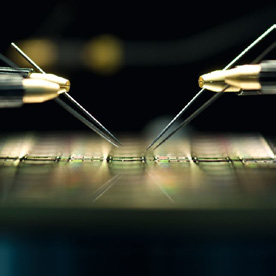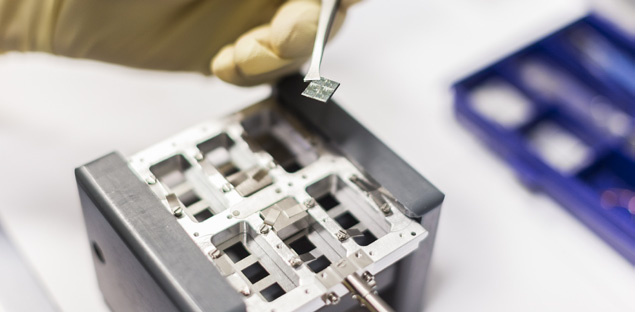Reflex over reaction
As part of the MARS project, Fraunhofer IIS / EAS and GLOBALFOUNDRIES have advanced the development of highly reliable 22 nm FDSOI components. These components are intended to pave the way for “tactile intelligent systems” made in Dresden. Areas such as autonomous driving and applications in intelligent production will benefit enormously from such wirelessly networked systems capable of communicating with each other in real time.


Every second counts? No – in an age of increasingly networked applications, even this is far from sufficient. Many systems must respond within mere fractions of a second. Examples of areas in which even faster applications will be required in the future include Car2X communication by autonomously driving vehicles and robot-assisted surgical operations. This will be made possible by the next generation of wireless real-time communication in what are called tactile intelligent systems (TIS) – systems characterized by real-time control, high computing power, numerous different sensors and actuators, high data rates, and minimal latency. With TIS, devices are not only capable of responding more quickly to signals from other systems, the environment, or users; they can also act “reflexively.” This opens up the possibility of a completely new form of interaction and networking. The market potential is correspondingly great. Due to their extremely low latency of less than a millisecond, tactile intelligent systems are of particular interest in areas such as Industry 4.0, robotics applications, medical technology, and the automotive industry.
Powerful and energy-efficient
One milestone for TIS is the production-ready 22 nm FDSOI (Fully Depleted Silicon on Insulator) technology developed in Dresden by GLOBALFOUNDRIES. FDSOI transistors contain a very thin but electrically very strongly insulating barrier layer of silicon dioxide that effectively prevents leakage current in the substrate. This means that less current is lost and the transistors can switch faster. In the case of the new chips from Dresden, this allows an almost hundredfold increase in the working speed of radio-controlled actuation and receiver units while also keeping energy consumption extremely low.
Forecasting models calculate aging processes even before production
Because the technology is intended primarily for use in safety-critical processes, 100-percent reliability must be guaranteed. The goal is to demonstrate that the components can do their work without issues even after extended periods of service. In the MARS project, researchers at the Fraunhofer Institute for Integrated Circuits IIS, Division Engineering of Adaptive Systems EAS have therefore worked on software tools, models, and methods that support the design capabilities and functional reliability of the 22FDX components. “The focus was on methods for simulations capable of verifying ten- to twenty-year reliability for the components,” explains Roland Jancke, who was responsible for the MARS work at Fraunhofer IIS / EAS. This included researching new and informative aging models for the new components. In contrast to earlier empirical models, these newly developed models are based on the actual physical effects. As a result, they permit predictions regarding the reliability under various usage conditions even before the first silicon is produced. Within the framework of the research project, the partners have been able to show that the prediction models and the initial measurement data already fit together well. More work is planned to take additional effects into account in the models.
The MARS project was funded by the European Union and the Free State of Saxony within the scope of the European Regional Development Fund (ERDF) (project number 100225166).
Last modified: